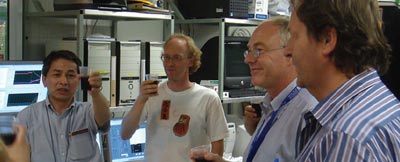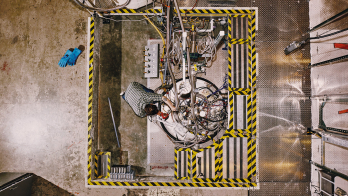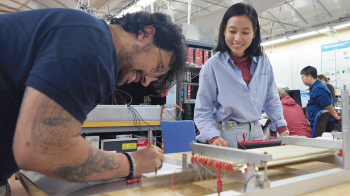The ATLAS Collaboration passed a major milestone during the evening of 1 August. The Central Solenoid, in its final position in the ATLAS cavern and with the final equipment, was commissioned up to 8.0 kA without quenches, exceeding its operational current of 7.73 kA for the magnetic field of 2 T. This makes the ATLAS Central Solenoid the first superconducting magnet to be fully commissioned in the underground areas of CERN’s Large Hadron Collider (LHC).

It is 12 years since the team led by Takahiko Kondo and Akira Yamamoto of the KEK laboratory in Japan proposed a thin solenoid magnet for the ATLAS experiment at the LHC. The solenoid provides a magnetic field of 2 T for momentum measurement in the inner detector part of the huge construction. Located inside the electromagnetic calorimeter, it must be thin to present as little material as possible to particles, in particular electrons and photons, produced in the proton collisions at the centre of the detector. The KEK proposal was to use specially hardened aluminium stabilizer for superconducting cables, saving about 30% in material thickness.

The solenoid also shares a common cryostat/vacuum vessel with the barrel liquid-argon (LAr) calorimeter, eliminating the need for two vacuum-vessel walls. This special configuration meant that the solenoid and LAr cryogenics teams had to collaborate perfectly from the beginning of the design stage all the way through to the commissioning that ended at the beginning of August. A highlight during construction was an exchange of final and test inner vacuum cylinders between the two projects in 2000, when the solenoid and the LAr barrel cryostat, which was the responsibility of Brookhaven National Laboratory, were being manufactured on the same Japanese island.
The solenoid commissioning has not only proved that the solenoid magnet built by KEK performs well, but it has demonstrated that all the control, cryogenic, power, vacuum and safety systems worked coherently – a major accomplishment by various CERN teams. In particular, very-high-precision current generation by the digitally-controlled power supplies enables the magnetic field to be reproduced reliably to an accuracy of 10–5. Following the commissioning, the collaboration also mapped the solenoid field.
Only a few days previously, a site-wide electric power failure had struck CERN for several hours, but thanks to well-designed emergency and recovery countermeasures, the solenoid was commissioned. This success with the ATLAS solenoid was a good start for commissioning even larger and more complex systems for the LHC and its experiments in the near future.








